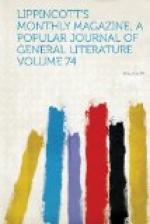Of the feathered spectators of the scene we have episodically glanced at, the most interested were those constant supervisors, the vultures. Of these there are three species, one of which—the Mexican vulture—is but an occasional visitor. The other two—the black vulture and the turkey-buzzard—are monopolists in their peculiar line. They constitute here, as generally throughout the warmer parts of the continent and its islands, the recognized sanitary police. No law protects them, but they do not need it. They are too useful not to command that popular sympathy which is the higher law. The flocks and herds upon a thousand plains are theirs. Every norther that freezes and every drought that starves some of the wandering cattle and sheep brings to them provision. The railroads also, not less than the winds of heaven, are their friends, the fatal cow-catcher being an ever-busy caterer. The buzzards are, of course, under such circumstances, warm advocates of internal improvement and welcome the opening of every new railway. Their ardor in this respect, however, has of late years been damped by the building of wire fences along the track, an interference with vested rights and an assault upon the hoary claims of infant industries against which in their solemn assemblies they doubtless often condole with each other. Unfortunately for their cause, they cannot lobby.
Somehow, there seems to be always a wag or clown among each group of animals,—some one species in which the amusing or the grotesque is prominent. Among these clownish fellows I should class the black vulture, or john-crow. He is not a crow at all, but gets that name probably because so historic a tribe as Corvus must have some representative, and the real crow, so common at the North, is one of the few birds that are not much seen in this quarter. John unites in his ways at once fuss and business. He alternates oddly between bustle and gravity. Seated stately and motionless for hours on a leafless tree, he will suddenly, as if struck by a new idea, start off on a tour that might have been dictated by telegram. He does not sail and circle like his friend and comrade, never being distracted by soaring pretensions, but goes straight to his object. His flight is a regular succession of short flaps, with quiescent intervals between the series. The flaps are usually four, sometimes five or six. I am sure he counts them. You have seen a pursy gentleman in black hurrying along the street and tapping his boot with a cane, as though keeping time. Fancy this gentleman in the air, dressed in feathers, his coat-skirt sheared off alarmingly short and square, and looking like a cherub in jet, all head and wings,—although John is not exactly a cherub in his habits. A white spot on each wing adds a bit of the harlequin to his style.




